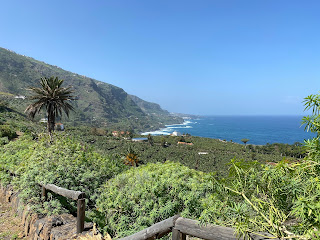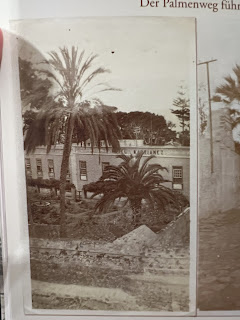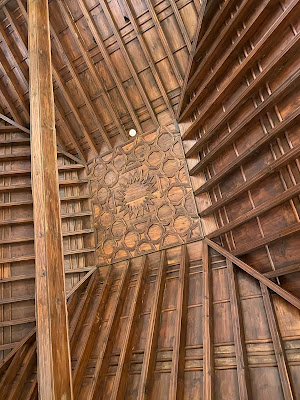Pisos de Vegetación
(Es)
Tras el terrible incendio que tuvimos en agosto, vamos a conocer de manera resumida los pisos de vegetación que tiene nuestra isla y así familiarizarnos más de los que nos rodea.
Empezamos desde la costa hasta la cumbre:
Matorral Costero
Cardonal-Tabaibal
Bosque Termófilo
Monteverde ( Laurisilva y Fayal-brezal)
Pinar
Zona de cumbre
Zona Baja o de Matorral Costero
Esta franja costera rodea la Isla, y va desde los 0 metros hasta un límite situado entre los 300-500 metros sobre el nivel del mar y varía según se trate de la vertiente norte o sur:
-La costa norte, zona más accidentada y húmeda, provoca un menor desarrollo de la vegetación típica de la zona de costa.
-Vertiente sur, menos accidentada y más seca, desarrollo más amplio de la flora de este piso de vegetación que puede llegar hasta los 500 m.
Algunas de las especies que encontramos están:
-Las psammófilas en las playas arenosas del sur, como El Médano, Los Cristianos…, La Caleta de Adeje, etc.
-El balancón (Traganummoquinii) o la tabaibilla (Euphorbia paralias).
-La halófila, compuesta por especies que viven en zonas muy cercanas al mar y en sustratos arenosos o rocosos: son el salado (Schizogyne sericea), la uvilla de mar (Zygophylum fontanesii) …
En los acantilados costeros de la zona sur podemos encontrar importantes endemismos, como en el Barranco del Infierno, que posee el único reducto de Sauces (Salix canariensis), de toda la isla.
Cardonal-Tabaibal
o matorral xerófilo, se desarrolla en la franja costera pero lejos del influjo directo de la maresía:
Las especies más representativas de esta comunidad son:
- El cardón (Euphorbia canariensis): puede aparecer hasta los 500 metros
-Las tabaibas (Euphorbia balsamifera, E. regis-jubae, etc.): pueden aparecer hasta los 300 metros
En las zonas de los barrancos aparecen especies diferentes a las anteriores:
-La palmera canaria (Phoenix canariensis)
-El balo (Plocama pendula),
-Diferentes tipos de bejeques (Aeonium)
-Verodes (Kelinia neriifolia) en las paredes rocosas
Bosque Termófilo
Formado por especies arbóreas y arborescentes, es un piso de transición entre la zona costera y el piso monteverde.
Un ejemplo de este tipo los encontramos en los Acantilados de La Culata, cerca de Garachico., donde se conserva la mejor muestra de bosque termófilo de la Isla. También lo encontramos en Teno y Anaga (zonas más aisladas), y en algunos barrancos del norte.
Este piso de vegetación ha sido el más utilizada tradicionalmente para la agricultura, por lo que la vegetación potencial ha sido roturada.
Las especias más representativas de este piso son:
-Las sabinas (Juniperus phoenicia), que en la Isla no son muy abundantes.
-La palmera canaria (Phoenix canariensis), que se puede observar en los valles y fondos de barrancos y en algunas laderas escarpadas, constituyendo un elemento fundamental del paisaje.
-El sauce (Salix canariensis): es un endemismo macaronésico de pequeño tamaño (arbusto o árbol pequeño).
-Los dragos (Dracaena drago), que son el símbolo vegetal de Tenerife, pudiéndose ver en grupos en las zonas del Macizo de Anaga o en el Barranco del Infierno, o dispersos, en la Comarca de Acentejo, Icod, Teno, etc.
Zona de Monteverde: Laurisilva y Fayal-Brezal
A partir de los 600 metros sobre el nivel del mar, en las zonas de barlovento de la Isla (eficaz el efecto de la masa de aire) , encontramos el Monteverde, que incluye la Laurisilva y el Fayal-brezal.
Se desarrolla sólo en las zonas más húmedas del norte y noreste de la Isla, entre los 600 y 1.200 m de altura (A esta cota se instala el mar de nubes, aportando a la vegetación la ‘lluvia horizontal’, sin la cual no podría existir).
La Laurisilva es, posiblemente, una de las formaciones arbóreas más conocidas de Canarias. Son especies de gran porte y se distinguen por sus hojas semejantes al laurel (de ahí el nombre de Laurisilva “selva de laurel”:
-El viñátigo (Persea indica)
-El laurel o loro (Laurus azorica),
- El acebiño y el palo blanco (Picconia excelsa).
-Tilo (Ocotea foetens),
-El barbusano (Apollonias barbujana) y el mocán.
- Infinidad de especies de musgos y líquenes, plantas trepadoras, helechos, etc.
La formación de Fayal-brezal aparece en la parte superior de la Laurisilva, donde el mar de nubes comienza a remitir;
-La faya (Myrica faya) y el brezo (Erica arborea) son las especies más abundantes y, a veces, las únicas.
Esta comunidad vegetal puede existir como zona de transición natural a los pinares, tanto en las cotas altas de Laurisilva, como en las marginales (zona de cambio de vertientes).
Pinar
En la fachada de sotavento (fuera de la afluencia de los vientos húmedos) desde los 700 hasta los 2.300 m; y en la fachada norte, por encima del Monteverde, desde los 1.200 hasta los 2.100 m de altitud, aparece el bosque de pinos.
Formación boscosa, formada principalmente por Pino canario (Pinus canariensis), una especie muy resistente a climas adversos. Es una formación abierta con un sotobosque:
-el escobón (Chamaecytisus proliferus),
-codesos (Adenocarpus foliolosus),
-jaras (Cistus monspeliensis),
- tomillos (Micromeria sp.)
-poleos (Bystropogon origanifolius).
La mejor representación de pinar en la isla de Tenerife se encuentra en el Parque Natural de la Corona Forestal.
Matorral de Cumbre o Alta Montaña
Por encima de la zona de pinar, sobre los 2.100 m, aparece la zona de alta montaña. A estas cotas, la vegetación se ha adaptado a las condiciones climáticas más duras, como escasez de precipitaciones, nieves, heladas, alta oscilación térmica…
Algunas de las especies son:
- La retama del Teide (Spartocytisus supranubius
-Codeso de cumbre (Adenocarpus viscosus)
-Cedro (Juniperus cedrus), único árbol que sobrevive en estas cotas y del que quedan escasos ejemplares
-Hierba pajonera (Descurainia buorgeana)
-Tajinaste, como el tajinaste picante o azul (Echium auberianum), que es más raro y que es endémico de esta zona.
-Violeta del Teide (Viola cheiranthifolia).
Vegetation Floors
(En)
After the terrible fire we had in August, we are going to
briefly learn about the levels of vegetation that our island has and thus
become more familiar with those around us.
We start from the coast to the Summit
Matorral Costero
Cardonal-Tabaibal
Bosque Termófilo
Monteverde (
Laurisilva y Fayal-brezal)
Pinar
Zona de cumbre
Low area or Coastal
Matorral
This coastal strip
surrounds the Island, and goes from 0 meters to a limit located between 300-500
meters above sea level and varies depending on whether it is the northern or
southern slope:
-The northern coast, a more rugged and humid area, causes
less development of the vegetation typical of the coastal area.
-Southern slope, less rugged and drier, broader development
of the flora of this vegetation floor that can reach up to 500 m.
Some of the species we found are:
-The psammophiles on the sandy beaches of the south, such as
El Médano, Los Cristianos..., La Caleta de Adeje, etc.
-The balancón (Traganummoquinii) or the tabaibilla
(Euphorbia paralias).
-The halophile, composed of species that live in areas very
close to the sea and on sandy or rocky substrates: they are the saltwater
(Schizogyne sericea), the sea uvilla (Zygophylum fontanesii)
In the coastal cliffs of the southern area we can find
important endemisms, such as in the Barranco del Infierno, which has the only
stronghold of Willows (Salix canariensis) on the entire island.
Cardonal-Tabaibal
or xeric scrub, develops on the coastal strip but far from
the direct influence of the sea:
The most representative species of this community are:
- The cardón (Euphorbia canariensis): it can appear up to
500 meters
-The tabaibas (Euphorbia balsamifera, E. regis-jubae, etc.):
they can appear up to 300 meters
In the ravine
areas, different species appear than the previous ones:
-The Canary Islands palm (Phoenix canariensis)
-The balo (Plocama
pendula),
-Different types of bejeques (Aeonium)
-Verodes (Kelinia neriifolia) on rock walls
Thermophile Foresta Area
Made up of arboreal and arborescent species, it is a
transition zone between the coastal zone and the Monteverde zone.
We find an example of this type in the Cliffs of La Culata,
near Garachico, where the best example of thermophilic forest on the Island is
preserved. We also find it in Teno and Anaga (more isolated areas), and in some
ravines of the north.
This vegetation floor has traditionally been the most used
for agriculture, so the potential vegetation has been plowed.
The most representative spices of this floor are:
-The junipers (Juniperus phoenicia), which are not very
abundant on the Island.
-The Canarian palm tree (Phoenix canariensis), which can be
seen in the valleys and bottoms of ravines and on some steep slopes,
constituting a fundamental element of the landscape.
-The willow (Salix canariensis): is a small Macaronesian
endemism (shrub or small tree).
-The Drago (Dracaena drago), which are the plant symbol of
Tenerife, can be seen in groups in the areas of the Anaga Massif or in the
Barranco del Infierno, or dispersed in the Region of Acentejo, Icod, Teno, etc.
Monteverde Forest
Area Laurisilva and Fayal-Brezal
From 600 meters above sea level, in the windward areas of
the Island (the effect of the air mass is effective), we find the Monteverde,
which includes the laurel forest and the fayal-heath.
It develops only in the most humid areas of the north and
northeast of the Island, between 600 and 1,200 m high (At this level the sea of
clouds settles, providing the vegetation with 'horizontal rain', without which
it would not be posible exist).
The laurel forest is, possibly, one of the best-known tree
formations in the Canary Islands. They are large species and are distinguished
by their leaves similar to laurel (hence the name laurisilva “laurel jungle”:
-The viñátigo (Persea indica)
-The laurel or loro (Laurus azorica),
- The acebiño and the palo blanco (Picconia excelsa).
-Tilo (Ocotea foetens),
-The barbusano (Apollonias barbujana) and the mocán.
The fayal-brezal formation appears in the upper part of the
laurel forest, where the sea of clouds begins to subside;
-The faya (Myrica faya) and the brezo (Erica arborea) are
the most abundant species and, sometimes, the only ones.
This plant community can exist as a natural transition zone
to pine forests, both in the high laurel forest levels and in the marginal ones
(zone of change of slopes).
Pine Forest Area
On the leeward façade (outside the influx of humid winds)
from 700 to 2,300 m; and on the north façade, above Monteverde, from 1,200 to
2,100 m altitude, the pine forest appears.
Forest formation, formed mainly by Canarian Pine (Pinus
canariensis), a species very resistant to adverse climates. It is an open
formation with an undergrowth:
-the escobón (Chamaecytisus proliferus),
-codesos (Adenocarpus foliolosus),
-rock rose (Cistus monspeliensis),
- thymes (Micromeria sp.)
- pennyroyals (Bystropogon origanifolius).
The best representation of pine forest on the island of
Tenerife is found in the Corona Forestal Natural Park.
Zona de Matorral or High Mountain Area
Above the pine forest area, above 2,100 m, the high mountain
area appears. At these levels, the vegetation has had to adapt to the harshest
climatic conditions, such as a lack of precipitation, snow, frost, high thermal oscillation...
Some of the species are:
- La retama del Teide (Spartocytisus supranubius
-Codeso de cumbre (Adenocarpus viscosus)
-Cedro (Juniperus cedrus), the only tree that survives at
these levels and of which few specimens remain
-Hierba pajonera (Descurainia buorgeana), wildpretii)
-Tajinaste, such as the spicy or blue tajinaste (Echium
auberianum), which is rarer and is endemic to this area.
-Violeta del Teide (Viola cheiranthifolia).

.JPG)



.jpg)



.jpg)
















